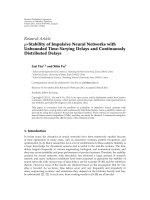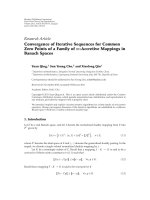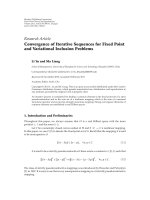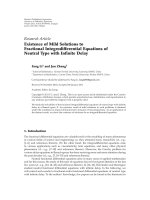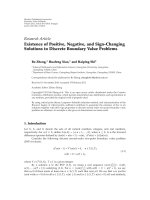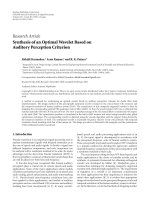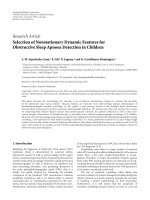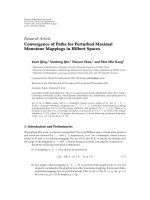Báo cáo hóa học: " Research Article Subclasses of Meromorphic Functions Associated with Convolution" ppt
Bạn đang xem bản rút gọn của tài liệu. Xem và tải ngay bản đầy đủ của tài liệu tại đây (482.29 KB, 9 trang )
Hindawi Publishing Corporation
Journal of Inequalities and Applications
Volume 2009, Article ID 190291, 9 pages
doi:10.1155/2009/190291
Research Article
Subclasses of Meromorphic Functions Associated
with Convolution
Maisarah Haji Mohd,
1
Rosihan M. Ali,
1
Lee See Keong,
1
and V. Ravichandran
2
1
School of Mathematical Sciences, Universiti Sains Malaysia, 11800 USM, Penang, Malaysia
2
Department of Mathematics, University of Delhi, Delhi 110 007, India
Correspondence should be addressed to Lee See Keong,
Received 12 December 2008; Accepted 11 March 2009
Recommended by Narendra Kumar Govil
Several subclasses of meromorphic functions in the unit disk are introduced by means of
convolution with a given fixed meromorphic function. Subjecting each convoluted-derived
function in the class to be subordinated to a given normalized convex function with positive real
part, these subclasses extend the classical subclasses of meromorphic starlikeness, convexity, close-
to-convexity, and quasi-convexity. Class relations, as well as inclusion and convolution properties
of these subclasses, are investigated.
Copyright q 2009 Maisarah Haji Mohd et al. This is an open access article distributed under
the Creative Commons Attribution License, which permits unrestricted use, distribution, and
reproduction in any medium, provided the original work is properly cited.
1. Introduction
Let H be the set of all analytic functions defined in the unit disk U {z : |z| < 1}. We denote
by A the class of normalized analytic functions fzz
∞
n2
a
n
z
n
defined in U. For two
functions f and g analytic in U, the function f is subordinate to g, written as
fz ≺ gz, 1.1
if there exists a Schwarz function w,analyticinU with w00and|wz| < 1 such that
fzgwz. In particular, if the function g is univalent in U, then fz ≺ gz is equivalent
to f0g0 and fU ⊂ gU.
A function f ∈Ais starlike if zf
z/fz is subordinate to 1z/1−z and convex if
1zf
z/f
z is subordinate to 1z/1−z. Ma and Minda 1 gave a unified presentation
2 Journal of Inequalities and Applications
of these classes and introduced the classes
S
∗
h
f ∈A
zf
z
fz
≺ hz
,
Ch
f ∈A
1
zf
z
f
z
≺ hz
,
1.2
where h is an analytic function with positive real part, h01, and h maps the unit disk U
onto a region starlike with respect to 1.
The convolution or the Hadamard product of two analytic functions fzz
∞
n2
a
n
z
n
and gzz
∞
n2
b
n
z
n
is given by
f ∗ gz
∞
n1
a
n
b
n
z
n
. 1.3
In term of convolution, a function f is starlike if f ∗ z/1 − z is starlike, and convex if
f ∗ z/1 − z
2
is starlike. These ideas led to the study of the class of all functions f such that
f ∗ g is starlike for some fixed function g in A. In this direction, Shanmugam 2 introduced
and investigated various subclasses of analytic functions by using the convex hull method 3–
5 and the method of differential subordination. Ravichandran 6 introduced certain classes
of analytic functions with respect to n-ply symmetric points, conjugate points, and symmetric
conjugate points, and also discussed their convolution properties. Some other related studies
were also made in 7–9, and more recently by Shamani et al. 10.
Let M denote the class of meromorphic functions f of the form
fz
1
z
∞
n0
a
n
z
n
, 1.4
which are analytic and univalent in the punctured unit disk U
∗
{z :0< |z| < 1}.
For 0 ≤ α<1, we recall that the classes of meromorphic starlike, meromorphic convex,
meromorphic close-to-convex, meromorphic γ-convex Mocanu sense, and meromorphic
quasi-convex functions of order α, denoted by M
s
, M
k
, M
c
, M
k
γ
, and M
q
, respectively, are
defined by
M
s
f ∈M
− R
zf
z
fz
>α
,
M
k
f ∈M
− R
1
zf
z
f
z
>α
,
M
c
f ∈M
− R
zf
z
gz
>α,g∈M
s
,
M
k
γ
f ∈M
− R
1 − γ
zf
z
fz
γ
1
zf
z
f
z
>α
,
M
q
f ∈M
− R
zf
z
g
z
>α,g∈M
k
.
1.5
Journal of Inequalities and Applications 3
The convolution of two meromorphic functions f and g, where f is given by 1.4 and gz
1/z
∞
n0
b
n
z
n
, is given by
f ∗ gz
1
z
∞
n0
a
n
b
n
z
n
. 1.6
Motivated by the investigation of Shanmugam 2, Ravichandran 6, and Ali et al.
7, 11, several subclasses of meromorphic functions defined by means of convolution with
a given fixed meromorphic function are introduced in Section 2. These new subclasses
extend the classical classes of meromorphic starlike, convex, close-to-convex, γ-convex,
and quasi-convex functions given in 1.5. Section 3 is devoted to the investigation of the
class relations as well as inclusion and convolution properties of these newly defined
classes.
We will need the following definition and results to prove our main results.
Let S
∗
α denote the class of starlike functions of order α. The class R
α
of prestarlike
functions of order α is defined by
R
α
f ∈A
f ∗
z
1 − z
2−2α
∈ S
∗
α
1.7
for α<1, and
R
1
f ∈A
R
fz
z
>
1
2
. 1.8
Theorem 1.1 see 12, Theorem 2.4. Let α ≤ 1, f ∈R
α
, and g ∈ S
∗
α. Then, for any analytic
function H ∈HU,
f ∗ Hg
f ∗ g
U ⊂
co
HU
, 1.9
where
coHU denotes the closed convex hull of HU.
Theorem 1.2 see 13. Let h be convex in U and β, γ ∈ C with Rβhzγ > 0.Ifp is analytic
in U with p0h0,then
pz
zp
z
βpzγ
≺ hz implies pz ≺ hz. 1.10
2. Definitions
In this section, various subclasses of M are defined by means of convolution and
subordination. Let g be a fixed function in M,andleth be a convex univalent function with
positive real part in U and h01.
4 Journal of Inequalities and Applications
Definition 2.1. The class M
s
g
h consists of functions f ∈Msatisfying g ∗ fz
/
0inU
∗
and
the subordination
−
zg ∗ f
z
g ∗ fz
≺ hz. 2.1
Remark 2.2. If gz1/z 1/1 − z, then M
s
g
h coincides with M
s
h, where
M
s
h
f ∈M
−
zf
z
fz
≺ hz
. 2.2
Definition 2.3. The class M
k
g
h consists of functions f ∈Msatisfying g ∗ f
z
/
0inU
∗
and
the subordination
−
1
zg ∗ f
z
g ∗ f
z
≺ hz. 2.3
Definition 2.4. The class M
c
g
h consists of functions f ∈Msuch that g ∗ ψz
/
0inU
∗
for
some ψ ∈M
s
g
h and satisfying the subordination
−
z
g ∗ f
z
g ∗ ψz
≺ hz. 2.4
Definition 2.5. For γ real, the class M
k
g,γ
h consists of functions f ∈Msatisfying g ∗fz
/
0,
g ∗ f
z
/
0inU
∗
and the subordination
−
γ
1
z
g ∗ f
z
g ∗ f
z
1 − γ
z
g ∗ f
z
g ∗ fz
≺ hz. 2.5
Definition 2.6. The class M
q
g
h consists of functions f ∈Msuch that g ∗ ϕ
z
/
0inU
∗
for
some ϕ ∈M
k
g
h and satisfying the subordination
− z
g ∗ f
z
g ∗ ϕ
z
≺ hz. 2.6
3. Main Results
This section is devoted to the investigation of class relations as well as inclusion and
convolution properties of the new subclasses given in Section 2.
Theorem 3.1. Let h be a convex univalent function satisfying Rhz < 2− α, 0 ≤ α<1, and g ∈M
with z
2
g ∈ R
α
.Iff ∈M
s
h,thenf ∈M
s
g
h. Equivalently, if f ∈M
s
h,theng ∗ f ∈M
s
h.
Journal of Inequalities and Applications 5
Proof. Define the function F by
Fz−
zf
z
fz
. 3.1
For f ∈M
s
h, it follows that
−R
zf
z
fz
< 2 − α, 3.2
and therefore,
R
z
z
2
f
z
z
2
fz
>α. 3.3
Hence z
2
f ∈ S
∗
α. A computation shows that
−
z
g ∗ f
z
g ∗ fz
g ∗−zf
z
g ∗ fz
g ∗ fFz
g ∗ fz
z
2
g ∗ z
2
fF
z
z
2
g ∗ z
2
f
z
. 3.4
Theorem 1.1 yields
−
z
g ∗ f
z
g ∗ fz
z
2
g ∗ z
2
fF
z
z
2
g ∗ z
2
f
z
∈
co
FU
, 3.5
and because Fz ≺ hz, it follows that
−
z
g ∗ f
z
g ∗ fz
≺ hz. 3.6
Theorem 3.2. The function f ∈M
k
g
h if and only if −zf
∈M
s
g
h.
Proof. The results follow from the equivalence relations
−
1
z
g ∗ f
z
g ∗ f
z
≺ hz ⇐⇒ −
z
g ∗ f
z
g ∗ f
z
≺ hz ⇐⇒ −
z
g ∗−zf
z
g ∗−zf
z
≺ hz.
3.7
Theorem 3.3. Let h be a convex univalent function satisfying Rhz < 2 − α, 0 ≤ α<1, and φ ∈M
with z
2
φ ∈ R
α
.Iff ∈M
s
g
h,thenφ ∗ f ∈M
s
g
h.
6 Journal of Inequalities and Applications
Proof. Since f ∈M
s
g
h, it follows that
−R
zg ∗ f
z
g ∗ fz
< 2 − α, 3.8
and thus
R
z
z
2
g ∗ f
z
z
2
g ∗ fz
>α. 3.9
Let
Pz−
zg ∗ f
z
g ∗ fz
. 3.10
A similar computation as in the proof of Theorem 3.1 yields
−
zφ ∗ g ∗ f
z
φ ∗ g ∗ fz
z
2
φz ∗ z
2
g ∗ fzPz
z
2
φz ∗ z
2
g ∗ fz
. 3.11
Inequality 3.9 shows that z
2
g ∗ f ∈ S
∗
α. Therefore Theorem 1.1 yields
−
zφ ∗ g ∗ f
z
φ ∗ g ∗ fz
≺ hz, 3.12
hence φ ∗ f ∈M
s
g
h.
Corollary 3.4. M
s
g
h ⊂M
s
φ∗g
h under the conditions of Theorem 3.3.
Proof. The proof follows from 3.12.
In particular, when gz1/z 1/1 − z, the following corollary is obtained.
Corollary 3.5. Let h and φ satisfy the conditions of Theorem 3.3.Iff ∈M
s
h,thenf ∈M
s
φ
h.
Theorem 3.6. Let h and φ satisfy the conditions of Theorem 3.3.Iff ∈M
k
g
h,thenφ ∗ f ∈M
k
g
h.
Equivalently M
k
g
h ⊂M
k
φ∗g
h.
Proof. If f ∈M
k
g
h, it follows from Theorem 3.2 that −zf
∈M
s
g
h. Theorem 3.3 shows that
φ ∗ −zf
−zφ ∗ f
∈M
s
g
h. Hence φ ∗ f ∈M
k
g
h.
Theorem 3.7. Under the conditions of Theorem 3.3,iff ∈M
c
g
h with respect to ψ ∈M
s
g
h,then
φ ∗ f ∈M
c
g
h with respect to φ ∗ ψ ∈M
s
g
h.
Proof. Theorem 3.3 shows that φ ∗ ψ ∈M
s
g
h. Since ψ ∈M
s
g
h, 3.9 yields z
2
g ∗ ψ ∈ S
∗
α.
Journal of Inequalities and Applications 7
Let the function G be defined by
Gz−
zg ∗ f
z
g ∗ ψz
. 3.13
A similar computation as in the proof of Theorem 3.1 yields
−
zφ ∗ g ∗ f
z
φ ∗ g ∗ ψz
z
2
φz ∗ z
2
g ∗ ψzGz
z
2
φz ∗ z
2
g ∗ ψz
. 3.14
Since z
2
φ ∈ R
α
and z
2
g ∗ ψ ∈ S
∗
α, it follows from Theorem 1.1 that
−
zφ ∗ g ∗ f
z
φ ∗ g ∗ ψz
≺ hz. 3.15
Thus φ ∗ f ∈M
c
g
h with respect to φ ∗ ψ.
Corollary 3.8. M
c
g
h ⊂M
c
φ∗g
h under the assumptions of Theorem 3.3.
Proof. The subordination 3.15 shows that f ∈M
c
φ∗g
h.
Theorem 3.9. Let Rγhz < 0.Then
i M
k
g,γ
h ⊂M
s
g
h,
ii M
k
g,γ
h ⊂M
k
g,β
h for γ<β≤ 0.
Proof. Define the function P by
Pz−
zg ∗ f
z
g ∗ fz
3.16
and the function J
g
γ; f by
J
g
γ; fz−
γ
1
zg ∗ f
z
g ∗ f
z
1 − γ
zg ∗ f
z
g ∗ fz
. 3.17
For f ∈M
k
g,γ
h, it follows that J
g
γ; fz ≺ hz. Note also that
J
g
γ; fzPz −
γzP
z
Pz
. 3.18
i Since Rγhz < 0and
Pz −
γzP
z
Pz
≺ hz. 3.19
8 Journal of Inequalities and Applications
Theorem 1.2 yields P z ≺ hz. Hence f ∈M
s
g
h.
ii Observe that
J
g
β; fz−
β
1
zg ∗ f
z
g ∗ f
z
1 − β
zg ∗ f
z
g ∗ fz
1 −
β
γ
Pz
β
γ
J
g
γ; fz.
3.20
Furthermore J
g
γ; fz ≺ hz and Pz ≺ hz from i. Since 0 <β/γ<1andhU is
convex, we deduce that J
g
β; fz ∈ hU. Therefore, J
g
β; fz ≺ hz.
Corollary 3.10. The class M
k
g
h is a subset of the class M
q
g
h.
Proof. The proof follows from the definition of the classes by taking f ϕ.
Theorem 3.11. The function f ∈M
q
g
h if and only if −zf
∈M
c
g
h.
Proof. If f ∈M
q
g
h, then there exists ϕ ∈M
k
g
h such that
− zg ∗ f
z
g ∗ ϕ
z
≺ hz. 3.21
Also,
−z
g ∗−zf
z
g ∗−zϕ
z
− zg ∗ f
z
g ∗ ϕ
z
≺ hz. 3.22
Since ϕ ∈M
k
g
h,byTheorem 3.2 , −zϕ
∈M
s
g
h. Hence −zf
∈M
c
g
h.
Conversely, if −zf
∈M
c
g
h, then
−
z
g ∗−zf
z
g ∗ ϕ
1
z
≺ hz3.23
for some ϕ
1
∈M
s
g
h.Letϕ ∈M
k
g
h be such that −zϕ
ϕ
1
∈M
s
g
h. The proof is completed
by observing that
− zg ∗ f
z
g ∗ ϕ
z
−
z
g ∗−zf
z
g ∗−zϕ
z
≺ hz. 3.24
Corollary 3.12. Let h and φ satisfy the conditions of Theorem 3.3.Iff ∈M
q
g
h,thenφ∗f ∈M
q
g
h.
Proof. If f ∈M
q
g
h, Theorem 3.11 gives −zf
∈M
c
g
h. Theorem 3.7 next gives φ ∗ −zf
−zφ ∗ f
∈M
c
g
h. Thus, Theorem 3.11 yields φ ∗ f ∈M
q
g
h.
Journal of Inequalities and Applications 9
Corollary 3.13. M
q
g
h ⊂M
q
φ∗g
h under the conditions of Theorem 3.3.
Proof. If f ∈M
q
g
h, it follows from Corollary 3.12 that φ ∗ f ∈M
q
g
h. The subordination
− zφ ∗ g ∗ f
z
φ ∗ g ∗ ϕ
z
≺ hz3.25
gives f ∈M
q
φ∗g
h. Therefore M
q
g
h ⊂M
q
φ∗g
h.
Open Problem
An analytic convex function in the unit disk is necessarily starlike. For the meromorphic case,
is it true that M
k
g
h ⊂M
s
g
h?
Acknowledgment
The work presented here was supported in part by the USM’s Reserach University grant and
the FRGS grant
References
1 W. C. Ma and D. Minda, “A unified treatment of some special classes of univalent functions,” in
Proceedings of the Conference on Complex Analysis (Tianjin, 1992), Con feren ce Proc eedi ngs an d Le cture
Notes in Analysis, I, pp. 157–169, International Press, Cambridge, Mass, USA, 1994.
2 T. N. Shanmugam, “Convolution and differential subordination,” International Journal of Mathematics
and Mathematical Sciences, vol. 12, no. 2, pp. 333–340, 1989.
3 R. W. Barnard and C. Kellogg, “Applications of convolution operators to problems in univalent
function theory,” The Michigan Mathematical Journal, vol. 27, no. 1, pp. 81–94, 1980.
4 R. Parvatham and S. Radha, “On α-starlike and α-close-to-convex functions with respect to n-
symmetric points,” Indian Journal of Pure and Applied Mathematics, vol. 17, no. 9, pp. 1114–1122, 1986.
5 S. Ruscheweyh and T. Sheil-Small, “Hadamard products of Schlicht functions and the P
´
olya-
Schoenberg conjecture,” Commentarii Mathematici Helvetici, vol. 48, pp. 119–135, 1973.
6 V. Ravichandran, “Functions starlike with respect to n-ply symmetric, conjugate and symmetric
conjugate points,” The Journal of the Indian Academy of Mathematics , vol. 26, no. 1, pp. 35–45, 2004.
7 R. M. Ali, V. Ravichandran, and S. K. Lee, “Subclasses of multivalent starlike and convex functions,”
to appear in Bulletin of the Belgian Mathematical Society. Simon Stevin.
8 K. S. Padmanabhan and R. Parvatham, “Some applications of differential subordination,” Bulletin of
the Australian Mathematical Society, vol. 32, no. 3, pp. 321–330, 1985.
9 K. S. Padmanabhan and R. Parvatham, “Some applications of differential subordination,” Bulletin of
the Australian Mathematical Society, vol. 32, no. 3, pp. 321–330, 1985.
10 S. Shamani, R. M. Ali, V. Ravichandran, and S. K. Lee, “Convolution and differential subordination
for multivalent functions,” to appear in Bulletin of the Malaysian Mathematical Sciences Society. Second
Series.
11 R. M. Ali, V. Ravichandran, and N. Seenivasagan, “Subordination and superordination of the Liu-
Srivastava linear operator on meromorphic functions,” Bulletin of the Malaysian Mathematical Sciences
Society. Second Series, vol. 31, no. 2, pp. 193–207, 2008.
12 S. Ruscheweyh,
Convolutions in Geometric Function Theory: Fundamental Theories of Physics, vol. 83 of
S
´
eminaire de Math
´
ematiques Sup
´
erieures, Presses de l’Universit
´
edeMontr
´
eal, Montreal, Canada, 1982.
13 P. Eenigenburg, S. S. Miller, P. T. Mocanu, and M. O. Reade, “On a Briot-Bouquet differential
subordination,” Revue Roumaine de Math
´
ematiques Pures et Appliqu
´
ees, vol. 29, no. 7, pp. 567–573, 1984.
